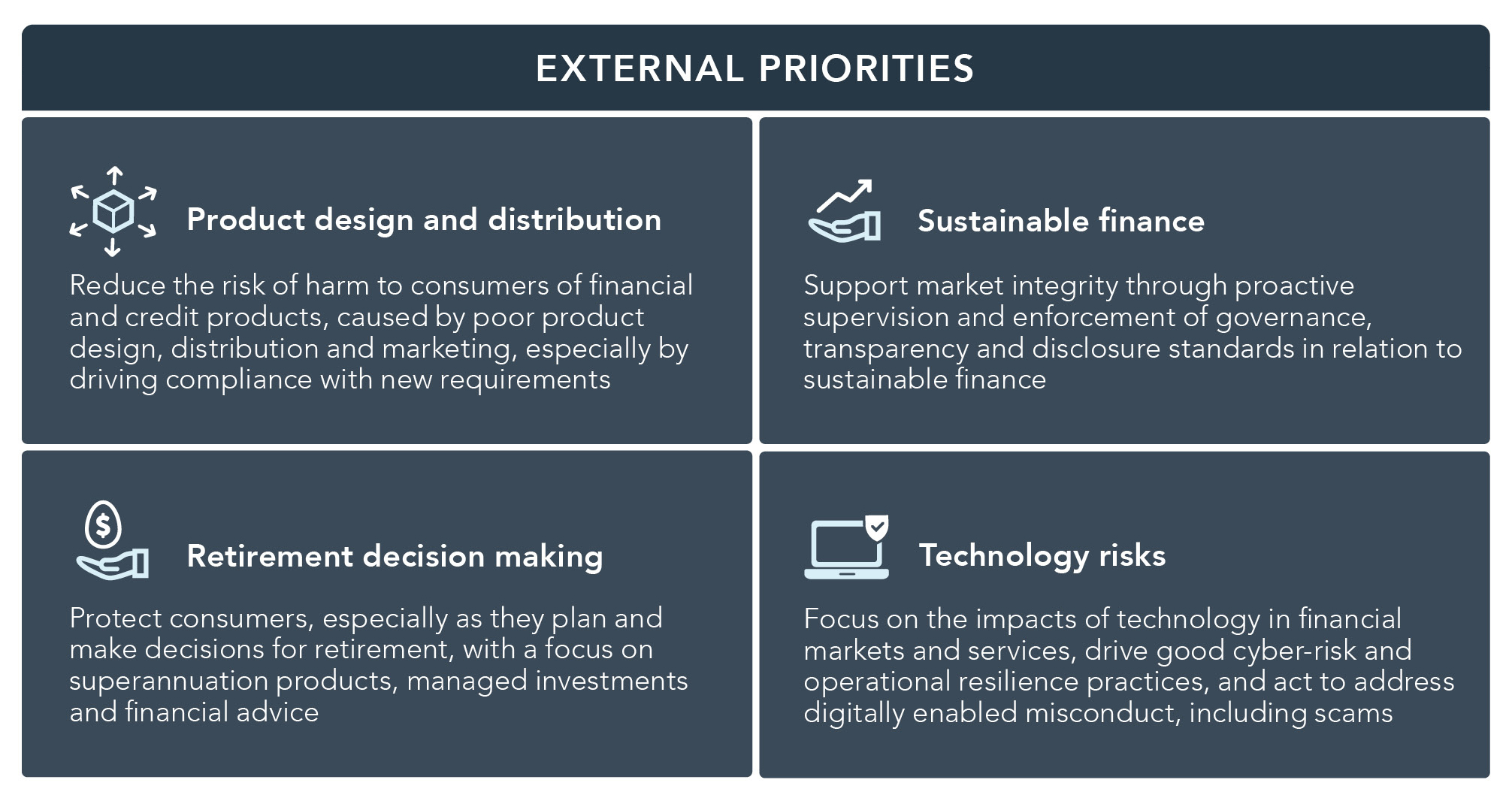ASIC’s priorities for the supervision of registered liquidators in 2022–23
ASIC has released its Corporate Plan 2022–26, outlining its strategic priorities for the next four years and its plan of action for the year ahead. (Click image to enlarge)
ASIC's external strategic priorities - text version
- Product design and distribution: Reduce the risk of harm to consumers of financial and credit products, caused by poor product design, distribution and marketing, especially by driving compliance with new requirements.
- Sustainable finance: Support market integrity through proactive supervision and enforcement of governance, transparency and disclosure standards in relation to sustainable finance.
- Retirement decision making: Protect consumers, especially as they plan and make decisions for retirement, with a focus on superannuation products, managed investments and financial advice.
- Technology risks: Focus on the impacts of technology in financial markets and services, drive good cyber-risk and operational resilience practices, and act to address digitally enabled misconduct, including scams.
We recognise that registered liquidators (RLs) faced challenges during and after COVID, including historically low numbers of insolvency appointments coupled with staff and resource challenges.
As we enter the 2022–23 financial year, the economic environment is again changing, and insolvency appointments are increasing. Our work in 2022–23 is focused on three main areas:
- high-risk liquidators and behaviours
- supporting RL investigations via the Assetless Administration Fund
- improving our data, analytics, technology capabilities and reporting to enhance our ability to identify and act on emerging harms, set strategic priorities, create efficiencies and inform policy.
We will also continue our stakeholder engagement activities and policy work, including the review and revision of existing regulatory guidance.
High-risk liquidators and behaviours
We continue our focus on high-risk liquidators and behaviours in the following key areas:
- Competency (compliance): We have seen significant failures in compliance over the last year. RLs we engage with tell us the compliance failures are in part because of loss of experienced staff, failure to maintain precedents to reflect amendments to the law (e.g. changes to lodgement requirements) and/or the RL has changed firms and no longer has the same level of support in either systems or precedents. In order to address the compliance failures we may issue the RL with directions to lodge documents which may result in late lodgement fees. If the direction is not complied with we may issue the RL with a direction not to take further appointments. We may also issue the RL with a Show Cause Notice in serious cases involving compliance and competency failures.
- Remuneration: We know that the low numbers of appointments over the last few years, coupled with reduced asset realisation prospects, may have put pressure on RLs to maintain levels of fees. This may result in remuneration charged that is not for necessary work or is for work that is not properly performed. We continue to monitor remuneration issues, including through reports of misconduct we receive that relate to excessive or inappropriate remuneration.
- Independence: We have developed a natural language processing (NLP) solution to identify independence risks. This technique uses automation and machine learning to search all DIRRIs (declarations of independence, relevant relationships and indemnities) as they are lodged. Machine flagged high-risk DIRRIs are manually reviewed and acted on if appropriate. This NLP solution has widened our ability to review all DIRRIs lodged rather than just look at a limited sample and has identified some behaviours and precedent materials we consider not to be appropriate.
Note: Machine learning is a subfield of artificial intelligence and computer science which focuses on computer systems learning and adapting statistical models and algorithms without explicit instructions to extract, analyse and draw inferences from patterns in data.
Supporting RL investigations via the Assetless Administration Fund
We assist RLs with funding from the Assetless Administration Fund (AAF) to carry out a proper investigation and report, or to take action to recover assets when serious misconduct is suspected. Our focus is:
- Illegal phoenix activity: Through taking director banning action and undertaking public examination in ‘other matter’ and ‘recovery action’ matters which disrupt the undesirable behaviour.
- Other misconduct: To protect consumers and investors from harm and bring to account the most egregious misconduct. This includes primary prosecution of directors which may also lead to prosecution of ‘untrustworthy and unscrupulous advisers’ for aiding and abetting.
- Recovery actions: Those that can be linked to significant misconduct, not just ordinary asset recoveries (e.g. debt collection), including funding of legal advice on prospects, undertaking public examinations and legal actions.
- Guidance on AAF funding requests: We also provide guidance so RLs can lodge effective requests for AAF funding through the Regulatory Portal. This maximises the strength of information provided by the RL and enables ASIC to better understand and assess the applications in a timely and efficient manner.
Improvement of our data, analytics, technology capabilities and reporting
We have increased our focus on collecting and analysing data so we can:
- identify high-risk RLs and emerging issues in the marketplace to allow us to focus our surveillance or enforcement activities and resources on individuals or issues that may cause most harm
- identify areas where market-wide education campaigns can remedy misconceptions or address areas of non-compliance
- report on the profile of corporate insolvency in Australia, including reporting to Government to support government policy formulation/decision making regarding corporate insolvency.
During the year we will:
- improve data available to the public through our insolvency statistics
- revamp and recommence our reporting of the data from the new Initial Statutory Report (replaced the EX01)
- publish a report on the work we do in both regulating and working with RLs.
Conclusion
We encourage you to use this information as a reference tool for your compliance, supervisory and risk management programs. We also recommend you subscribe to our quarterly Corporate Insolvency Update to stay informed about regulatory developments and issues affecting corporate insolvency markets.



